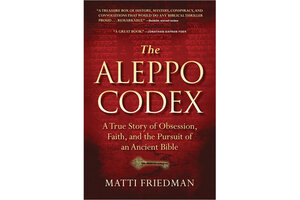The Aleppo Codex
The most accurate Biblical codex in Jewish tradition – a book revered both for its linguistic precision and its beauty – has been a victim of intentional deceit and government cover-ups.

The Aleppo Codex:
The True Story of Obesession, Faith, and the International Pursuit of an Ancient Bible
By Matti Friedman
Algonquin Books
320 pp.
International war, the gradual yet violent retreat of colonialism, and the ongoing construction of a universal Jewish homeland were the brush strokes that colored the uncertain infancy of Israel’s statehood. The challenges posed by five simultaneously invading armies aside, Israel’s leaders undertook the difficult task of cultivating the cultural Jewish identity that would transform their nation into the proper historical home for a people who had been without one for nearly two millennia. Part of this work included corralling the great Torah scrolls, Biblical codices, and rabbinical writings that had sustained the unity of the Jewish faith in its fractured diaspora since the destruction of the Temple by Titus’ legions in 70 A.D.
The Aleppo Codex, known as the Crown of Aleppo, was identified as a foundational Hebrew text, one that belonged within the borders of the new Jewish polity. Matti Friedman, a Middle Eastern correspondent for the Associated Press, navigates through intentional deceit and government cover-ups in The Aleppo Codex: A True Story of Obsession, Faith, and the Pursuit of an Ancient Book, a work that catalogs the convoluted – and often deliberately misleading – history of one book’s journey into the hands of the fledgling Jewish state.
In tenth century Tiberias, the renowned rabbi Aaron Ben-Asher dictated the most accurate and revered Biblical codex, bestowed with the honorific title of Crown, in Jewish history. It was revered not only for its linguistic precision, but also because, “from beginning to end, it was the same writing … the same shape. That was the beauty.”
The Crown was not destined to remain long in any one place. After a wealthy benefactor purchased the codex and gave it to Jerusalem’s chief rabbis in the eleventh century, Duke Godfrey of Bouillon led his Crusaders in 1099 to sack the Holy City and take control of the Crown. Upon learning of Jerusalem’s fall the wealthy Jewish community of Fustat, located on the Nile near Cairo, pooled money and paid to have the Crown rescued. In the twelfth century, famed Jewish scholar Maimonides, himself a resident of Fustat, used the Crown as the authoritative text upon which he based his Mishneh Torah, an important set of commentaries on law that remains fundamental to Jewish faith and scholarship today.
In the late fourteenth century the Crown was taken to Aleppo, along with a substantial community of Jews who were avoiding political turmoil in Cairo. The Crown remained in Aleppo’s great synagogue for over six centuries, carefully guarded by the community and its Sextons, a line of men expressly charged with the safekeeping of this cultural gem. The calm in Aleppo was interrupted by the events that transpired in New York on November 29, 1947. That afternoon the United Nations, in accordance with the votes of its members, declared the establishment of a Jewish state in the heart of Palestine.
Following this verdict, Jews became less and less welcome in Muslim lands, especially in communities like Aleppo, where the news from New York prompted anti-Jewish riots and the burning of the very synagogue that housed the Crown.
A great deal of snobbery and ethnic hierarchy among Jews themselves drove many of the new land’s leaders to seek out the religion’s academic treasures under the assumption that articles such as the Crown were neither safe nor properly cared for in the incapable hands of Jews, “from the backward Levantine countries.”
The latter half of the book chronicles Friedman’s odyssey throughout Europe, the Middle East and the United States, to determine exactly when, where and how the Aleppo Codex managed, at numerous times since the inception of the state of Israel, to be stolen, smuggled, or have significant sections go mysteriously and inexplicably missing.
Friedman’s clear writing and dogged pursuit of some otherwise overlooked assumptions read more like a detective novel than history. His startling finds demonstrate the ruthless underside of Zionist conviction that fueled the accumulation of an international Jewish library alongside the creation of a unique state.
Friedman has written an important account in accessible, gripping prose. After tracking the thousand-year history of the Crown, which narrowly escaped precarious violence and upheaval in Jerusalem, Egyp,t and Syria, it is shocking to learn that the chief thefts and crimes were perpetrated by a number of Israel’s highest ranking officials, supposedly the very people who were entrusted with ensuring the priceless relic’s safekeeping.
Jackson Holahan is an occasional book reviewer for the Monitor.

